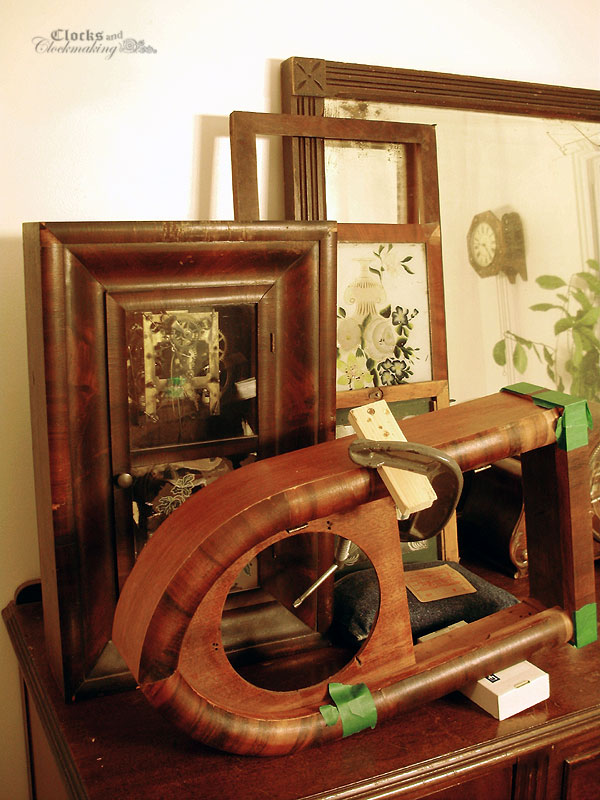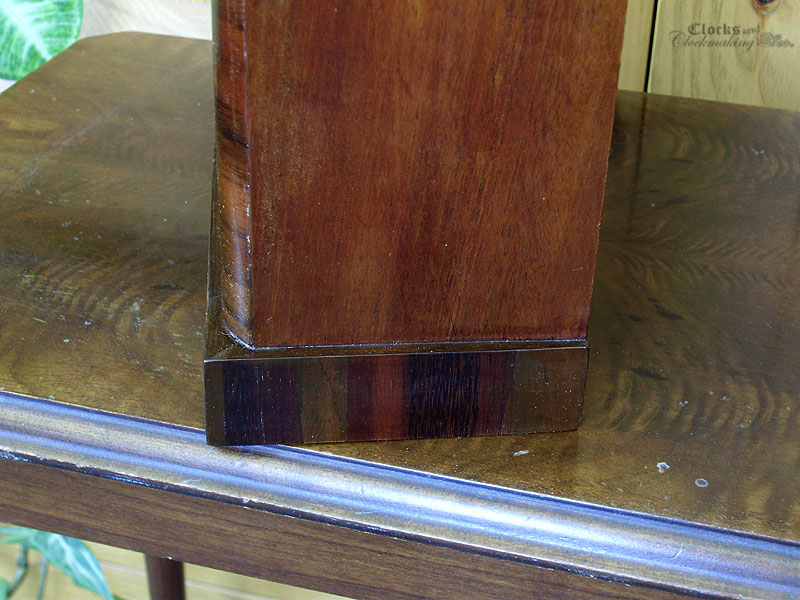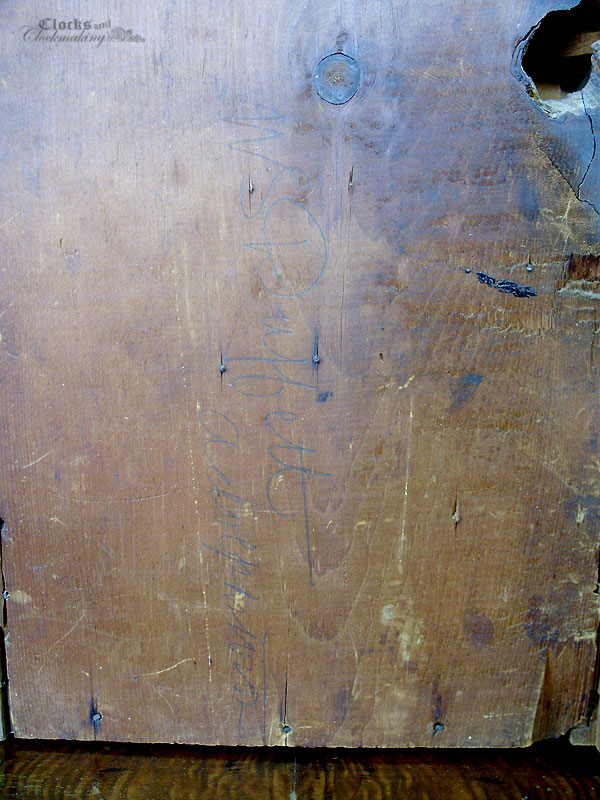
When I bought the clock originally, it wasn't in the best condition. The finish was still original, but crazed and chipped. There were several veneer chips, and the bottom right corner of the clock was badly broken, and held together with a small wire nail.
As is often the case, I thought I had more "before" photos, but unfortunately I only have a handful.


The clock came with 3 beautiful antique keys, unfortunately, none of them fit the clock correctly. The one on the upper right is close, but a bit of a sloppy fit.





Not too long after getting the clock, I stripped off the old finish, only to discover during the process that the bezel was grain-painted. I was able to very gently remove most of the shellac without damaging much of the paint, but about 1/3 of the original grain paint was lightly damaged.



Since stripping the clock, I've put off working on the case repairs. I did not have any rosewood veneer, and I was dreading the curved veneer repairs. I had the parts labeled and in separate bags (movement, dial, gong spiral) and boxes (wooden chunks, gong base, etc).
Earlier this month, and a little bit at the beginning of 2015, I started making lots of veneer and case repairs on several clocks all at once (with this one in the mix). The case needed part of the dial mask and internal support blocks glued, the base and corner piece reglued, and a little over a dozen veneer repairs.



I was able to repair the grain painting to he bezel quite easily, and the entire case was refinished with traditional orange shellac.



The movement was a standard early Waterbury pinned movement. It was in good shape, with the exception of awful hole-closing punch damage.


Very deeply marked hole-closing punch damage. This was an early repair method that is no longer considered acceptable.

This one makes the least sense. This is the motion works wheel, which carries no tension/force from the works, yet it was the most severely and deeply punched hole. This wheel should never require any bushing wear. It technically doesn't even require oiling. The only work that this gear carries out is to advance the hour hand.


There are also small punch marks on the interior on the worn sides of some pivot holes.

This is the only bushing on the movement. It was poorly made/fitted to the back side of the escape wheel.

The springs seem to be the originals, and they are good candidates for replacement. I chose to leave them in the clock for now to see if it would work as-is, but as it turns out the movement is not in top working condition. I will need to open it up again and install a few bushings as well as replace both springs. For the time being, I'm just happy that the clock is all back together.


The completed clock turned out nicely. It's interesting to note that this is considered a rosewood clock, yet the sides and the dial mask are done in mahogany veneer. This is quite common, and normally under a slightly darker finish the difference is very hard to see. Rosewood was more expensive, so it was only used on the front. Some smaller clocks are sometimes entirely rosewood veneered, so it varies.

Also note: the hour hand is the original, while the minute hand is a modern replacement.

One of the nicest features of the clock is the original tablet in mint condition. There is very minimal paint lift to some of the white, as well as several small dots of missing black (not very visible).

Two large veneer patches. About a one inch section of rosewood at the base of the curve (a nearly perfect match), and a vertical patch in the base.

These two patches are a bit more obvious, since the colour did not turn out as well as some of the other areas.

Three patches here, also a bit more visible. The colours looked great before the shellac. Luckily the rosewood has a wide variety of shades.


There are 3 or 4 patches and glue repairs on the curve here, but mostly just one of them shows (with the diagonal cut). In general it's always better to replace an entire "stripe" of veneer, but this spot was repaired with matching antique veneer, so I opted for a smaller repair. Also note the touched-up grain painting on the bezel.

Original grain painting.



The label on this clock is in excellent condition.

The back of the case bears a label to a Kingston, Ontario watchmaker. There was a pencil inscription on the right, but it is now largely gone. As far as I was able to research, this seems to indicate a repair or service date from around the 1890s. The clock dates from the early 1870s.

Full view of the backboard:

There is an inscription that reads" W. S. Duffett, Adolphustown. I was able to trace this down to a William Sealy Duffett (1837 - 1916) who passed away in Adolphustown Ontario. I wasn't able to find much more information on him other than his wife Mary Adalaide Watson, whom he married in Feb 1884. The clock seems unlikely to have been a wedding gift since the date is too late. By around 1874 Waterbury had changed their movement design to have screws on the front rather than pins.

Additionally this clock came with a note (visible at the beginning) that reads:
CAPT. ALLEN'S CLOCK
E. CATHERINE HARKNESS
5th GENERATION
I can find no relation between any captain Allen and the Duffett family, and without any indication of the captain's first name, there are a number of possibilities. There is Captain Christopher C. Allen (1846 - 1915), Captain Adam Allen (1813 - 1885), Capt John Allen (1837- 1913), and Captain Allen Mackenzie Cleghorn (d.1916), which would all conflict with the Duffett information. I imagine that if this clock belonged to a "captain Allen" it would have been sold to him after Mr. Duffett's death in 1916.
My search for E. Catherine Harkness also didn't turn up any useful results.
The clock was sold to me through an auction from collectors with the last name MacDonald, so I'm not sure how this clock might have been in any way "5th generation". The note may have been with the wrong clock?

No comments:
Post a Comment